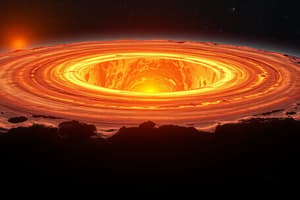Podcast
Questions and Answers
How was the Earth formed according to the accretion hypothesis?
How was the Earth formed according to the accretion hypothesis?
The Earth was formed through the process of accretion, where gravity attracts tiny bits of matter, leading to the formation of planetesimals and protoplanets.
What is the difference between homogeneous and heterogeneous accretion?
What is the difference between homogeneous and heterogeneous accretion?
Homogeneous accretion involves materials of the same composition, while heterogeneous accretion results in a differentiated planet as it grows.
Why is water considered the medium of life?
Why is water considered the medium of life?
Water is essential for life as it provides stability in aquatic habitats and is involved in numerous biochemical processes.
What is the origin of water formation on Earth according to prevailing hypotheses?
What is the origin of water formation on Earth according to prevailing hypotheses?
The global freshwater supply is __% compared to saltwater.
The global freshwater supply is __% compared to saltwater.
What percentage of the sun's energy is reflected and scattered by clouds, atmosphere, and Earth's light-colored surfaces?
What percentage of the sun's energy is reflected and scattered by clouds, atmosphere, and Earth's light-colored surfaces?
What major gases make up the Earth's atmosphere?
What major gases make up the Earth's atmosphere?
Which layer of the atmosphere contains the ozone layer?
Which layer of the atmosphere contains the ozone layer?
The thermosphere is the coldest layer of the atmosphere.
The thermosphere is the coldest layer of the atmosphere.
What is Earth's energy budget?
What is Earth's energy budget?
Match the following layers of the atmosphere with their specific features:
Match the following layers of the atmosphere with their specific features:
Flashcards are hidden until you start studying
Study Notes
Formation of Planet Earth
- Accretion Process: Earth formed through accretion, where gravity draws small matter towards a larger object, leading to the creation of planetesimals and protoplanets.
- Homogeneous Accretion: Occurs when Earth coalesces from materials of uniform composition, explaining the presence of volatile elements in the core.
- Heterogeneous Accretion: Involves the accumulation of diverse materials during condensation, resulting in a differentiated planet as it increases in size.
- Challenges: Homogeneous accretion struggles to account for the presence of specific elements like osmium and iridium, while heterogeneous accretion requires rapid formation, conflicting with impact crater evidence.
Water: The Medium of Life
- Hydrosphere Definition: Encompasses all water on Earth, divided into saltwater (97.5%) and freshwater (2.5%).
- Freshwater Characteristics: Distinguishes freshwater from saltwater by having minimal to no salt content.
- Origin of Water: Theories suggest water arrived via comet collisions or was present as volatiles in Earth's magma during formation.
- Properties of Water: Maximum density occurs at 3.98°C; its high heat capacity stabilizes aquatic habitats, making them supportive environments for life.
Sun as the Main Source of Energy
- Solar Energy Role: The Sun is critical for powering many Earth processes, including photosynthesis in plants.
- Albedo Effect: Reflects the property of objects to absorb or reflect light, impacting energy retention, with values ranging from 0 to 1.
- Earth's Energy Budget: Represents the balance of solar energy absorbed versus reflected; about 30% of solar energy is reflected back into space.
- Influencing Factors: The energy budget is affected by light-colored surfaces, radiation amount, axial tilt, and greenhouse gas presence.
Earth’s Atmosphere
- Composition: Mainly consists of nitrogen (78%) and oxygen (21%); trace gases like argon (0.9%) and essential gases like carbon dioxide and ozone (0.1%) play critical roles in life.
- Atmospheric Layers: Divided into five main layers: troposphere, stratosphere, mesosphere, thermosphere, and exosphere.
- Troposphere Characteristics: The lowest layer where most life exists; its thickness ranges from 5 to 9 miles (8 to 14 km).
- Stratosphere Content: Contains the ozone layer, acting as a shield against harmful UV radiation.
- Ozone Types: Stratospheric ozone is beneficial for protecting life; tropospheric ozone can be harmful, causing respiratory issues and damaging plants.
- Thermosphere Details: Very high temperatures can reach 1500°C; it extends about 600 km thick.
- Exosphere Definition: The outermost layer, encompassing the boundary with outer space, extending around 10,000 km.
- Hydrologic Cycle Role: The atmosphere is essential for the water cycle, serving as a reservoir and facilitating the global movement of water.
Studying That Suits You
Use AI to generate personalized quizzes and flashcards to suit your learning preferences.




